 |
Hempstead |
|
what3words location - ///paces.vegans.hissing |
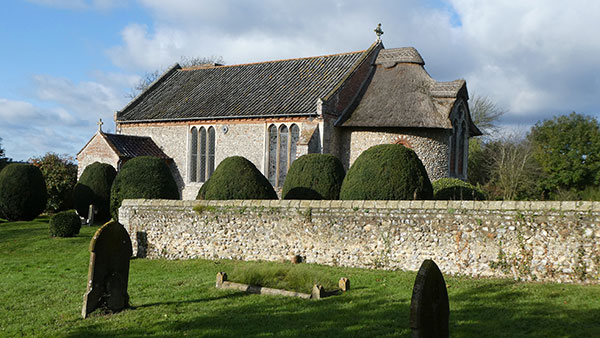 |
Hempstead church and its parish are a member of the Matlaske benefice, which is a benefice containing seven churches in the Holt Deanery within the Diocese of Norwich. |
Hempstead church is a Grade ll listed building, originally dated as late Saxon or Saxo-Norman but was almost entirely demolished and then rebuilt slightly to the south around the year 1300 and the line of the original Saxon Church walls are in places, visible in the grass. |
The parish of Hempstead-by-Holt is about 2 miles south-east of Holt. Hempstead is mentioned in the Domesday Book and probably gave its name to Simon de Hempstede of Netherhall Manor - the first holder of the advowson of All Saints. The manor house stood to the west of the church and its remains have been excavated in recent years. Decorated tiles found during the excavations can be seen in Norwich Castle Museum. |
Parish church, C14 and later, altered and re-roofed in C18. Coursed flint and brick with black glazed pantile roof. North-west tower and vestry, nave (formerly south aisle) with apse, south porch. Tower: medieval east half of flint, west half rebuilt in brick, dated 1744 on plaque on south side; brick parapet; bell openings on all 4 sides in honeycombed brick; 2 large stepped buttresses in brick to west. Medieval gargoyle incorporated into low flint lean-to under pantiles to west. Buttress to south of tower in undressed flint. West wall of nave in galletted coursed flint; brick parapet to gable; early C14 2-light window under trefoil. Nave walls of coursed flint; eaves rebuilt in brick with dentil cornice; 2 windows each side of 3 lights with plain heads, the mullions, some renewed, are medieval with tracery removed. Two C18 slanting brick buttresses to north. One brick and flint buttress of 1925 to south wall. Brick east gable surmounted by cross. Thatched apse of 1925 in pebble flint with brick dressings; two narrow round headed lights; east window of 1876 in C14 style repositioned in apse, 2 lights under a trefoil, label stops of foliage. Porch with plain rendered brick arch; brick gable surmounted by cross; quoins of alternating narrow bricks and flints. South door with deep continuous ogee moulding under hood mould. Vestry to east of tower, of rendered flint with lean-to roof of black glazed pantiles to present nave has north doorway, with internal rear arch, now blocked and part glazed, with hollow chamfered continuous moulding and deeply rolled hood mould. Interior: C18 west galley supported by earlier moulded joists; large rendered round headed arch to vestry, possibly C18; tall plain tower arch to vestry; one medieval bench with multilated poppy heads; late C17/early C18 communion table with renewed top; communion rails incorporate thin C18 barley sugar balusters; chancel fittings of 1876; one medieval encaustic tile by door. |
Our Church & Village News magazine is shared with Baconsthorpe, Barningham Winter, Edgefield, Matlaske, Plumstead and Saxthorpe with Corpusty. The current copy and back copies can be viewed Here |
Church & Village News correspondent |
Jonathan Neville - 07836 675369 jneville@hempstead-norfolk.co.uk |
| Rector | Revd. Canon David Longe - 01263 577252 |
| Lay Minister | Judy Rosser - 01263 587584 |
| Authorised Worship Assistant | Dr. Alain Wolfe - 01263 577292 |
| Church Warden | Airlie Inglis - 01263 577440 |
| Instagram Account | hempsteadallsaints |
|
||||||||
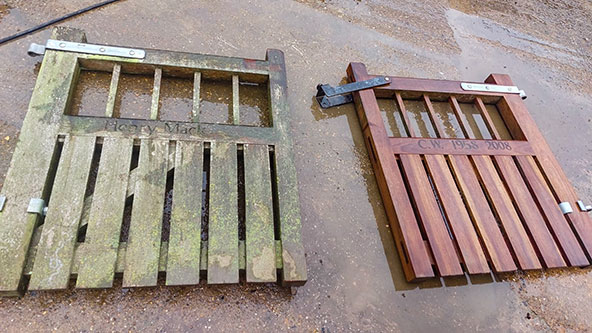 |
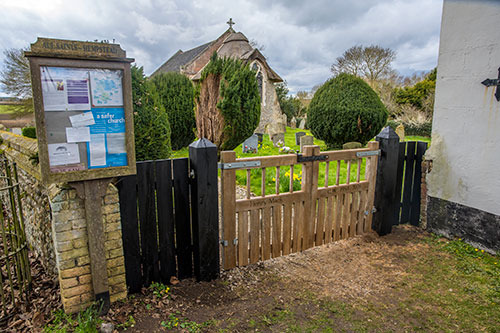 |
The church gates have been cleaned, the fencing creosoted and the right hand post replaced. William Mack supplied the labour and the new post was supplied by Charles Inglis. |
|
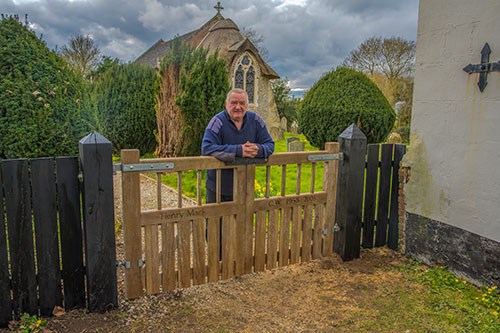 |
|
William Mack with the cleaned gates - his father Henry Mack, was Church Warden from 1958 - 2008. |
|
Church website -
https://www.achurchnearyou.com/church/10333 Church Instagram account - https://www.instagram.com/hempsteadallsaints/ |
|
|
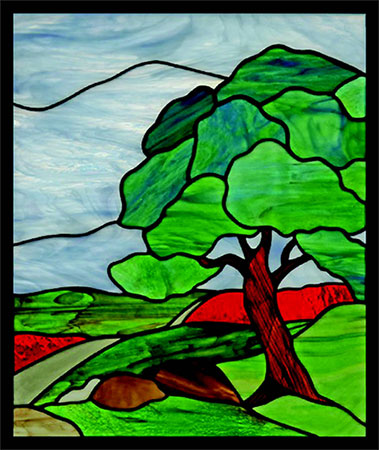 |
|---|
Stained glass wndow by Su Summers - 2018 |
A retirement promise was to learn something new. It turned out to be more than one 'something', starting with learning to play the harp, and then by learning to work with glass. Both have been a challenge, but immensely satisfying. I love the natural world and my work in glass usually reflects this. Su Summers 1949-2020 |
David Durst reported that after some months of silence the church bell had been repaired and replaced. The failure was in one of the iron straps which hold the bell into the headstock; all the wrought iron fittings had to be replaced. Whilst dismantled, all the moving parts were looked at, and numerous minor repairs effected. The initial delay arose because it was suggested that we should also drill out and replace the “crown staple” which is the cast in wrought iron loop on which the clapper hangs. In general this is the commonest cause of sudden bell fracture; it arises due to the different materials and cumulative rusting. We argued that in this case the risks while doing the extra work were just as great as those to be guarded against and eventually we prevailed. |
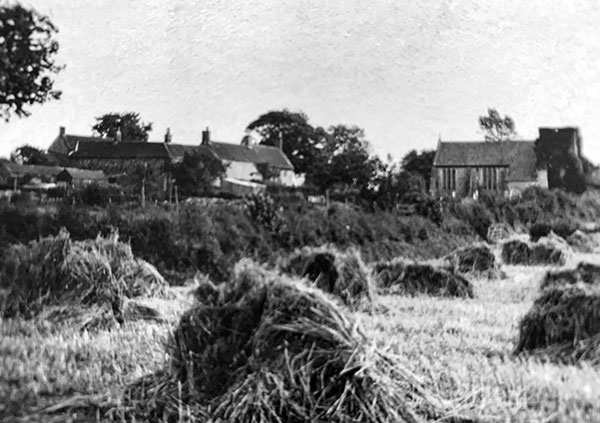 |
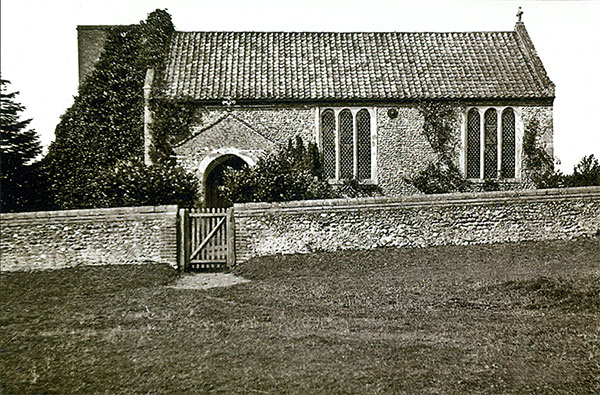 |
Hempstead All Saints church without its apse and with its graveyard wall before the graveyard was enlarged - c.1900 |
|
A Saxon-Norman church with west tower, and perhaps a slightly later Norman south doorway stood to the north of the present building. It was mostly demolished, after it had received a new north doorway in the 13th Century, and the present church erected around 1300, perhaps following an attempt to make a nave with two aisles had failed. |
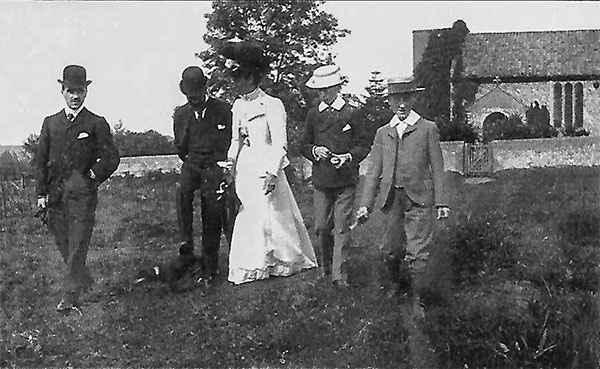 |
| Churchgoers returning to the Vicarage across what is now the Playing Field - c.1900 The original churchyard wall is visible before being removed when the churchyard was enlarged in 1906. |
The churchyard was extended in 1906 and rimmed by wrought iron railings. Behind these is an unruly laurel hedge. The railings are beyond repair so prompted by a substantial anonymous donation the railings and hedge will go. The sections facing the road and drive will be marked by a wall; for the rest the railings will be re-furbished. |
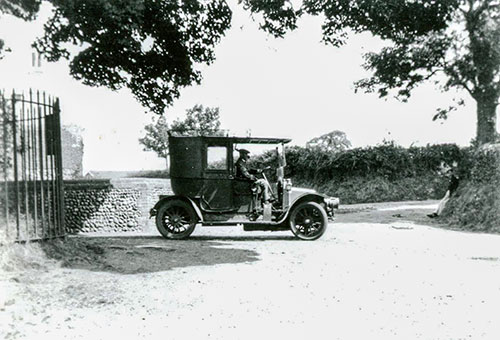 |
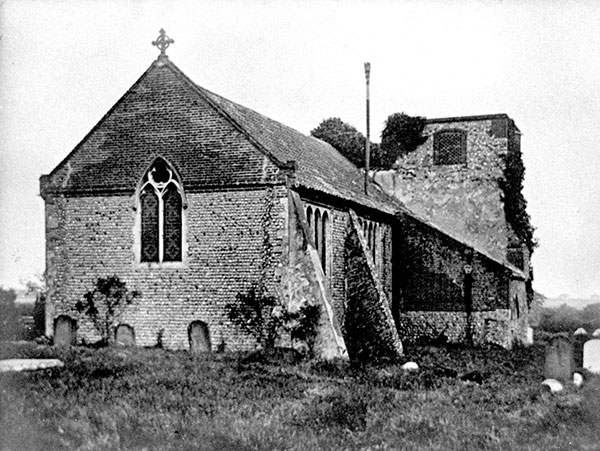 |
Road entrance to the church clearly showing the railings around the sycamore tree - c.1920 |
Church without its apse - c.1920 |
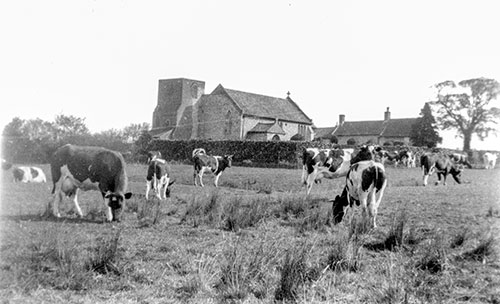 |
The trimmed laurel hedge surrounds the churchyard and a conifer tree stands near the gable end of the southern Church Cottage. - c.1930 |
| The Church has a brick tower, built in 1744, and is a vicarage . . . White's 1836 |
The stained east window is a memorial, and was inserted in 1876 by the Rev. Charles Louis Rudd M.A. vicar 1873-89, who also presented a carved oak reredos and massive brass lecturn Kelly's 1892 |
| In 1915 a memorial window was inserted to Richard Hardy, sometime churchwarden Kelly's 1916 |
The chancel, which is of flint with brick facings, and which has a thatched roof, was erected in 1930 by public subscription Kelly's 1933 |
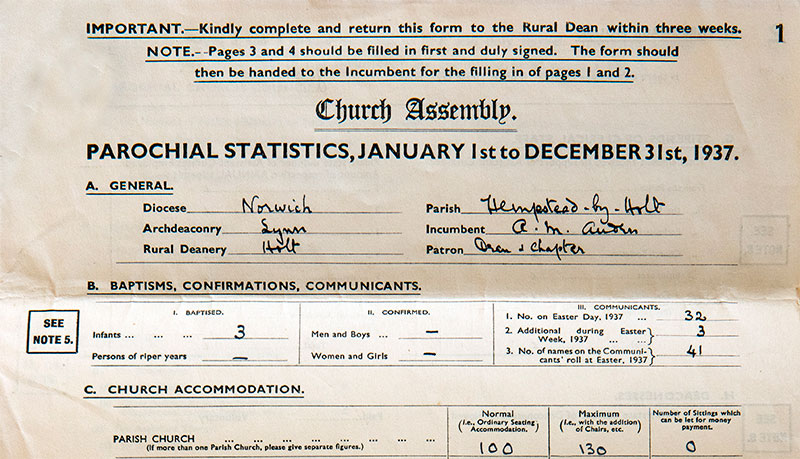   |
    |
 |
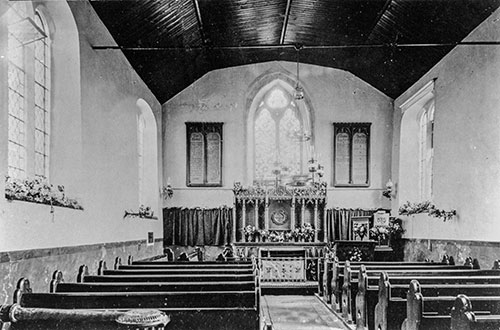 |
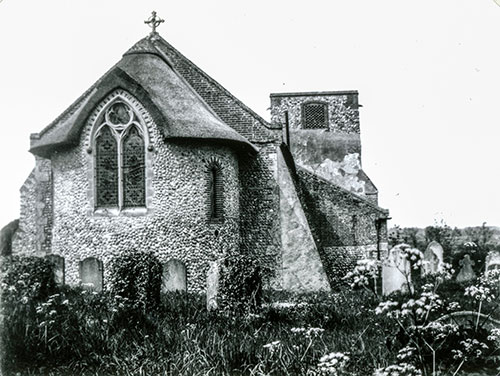 |
Church interior before the apse was added in 1925 - c.1900 |
c.1960 |
The older style box pews were changed to open pews in 1898.
The plaster ceiling was replaced by march boarding c.1900 and could have been part of the same project as the pews change. |
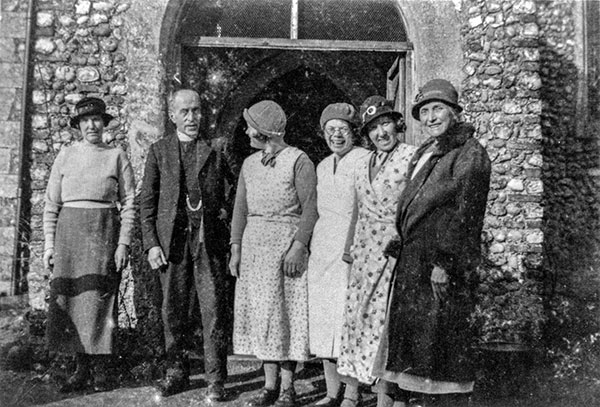 |
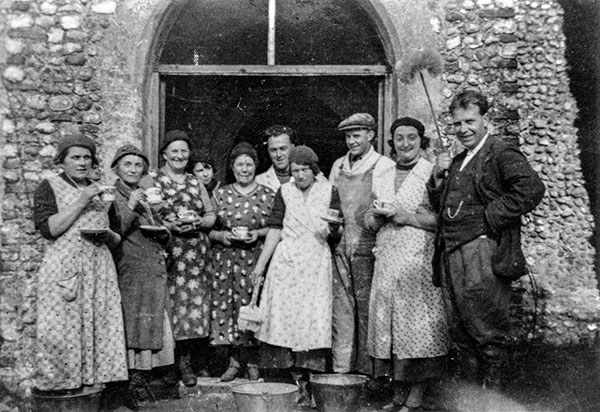 |
Rev Alfred Auden with the cleaning party that includes Mrs Jimmy Roy and Mrs Sam Clark in 1934 |
Cleaning and decorating party that included Mrs Fuller, Mrs Sam Clark, Mrs Ward, Mrs Fanny Doy, Mrs Nellie Everitt, Jimmy Whitton and others |
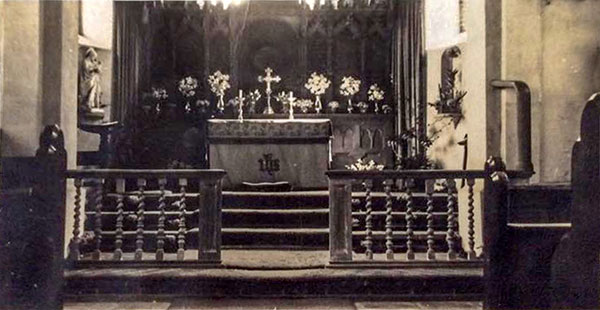 |
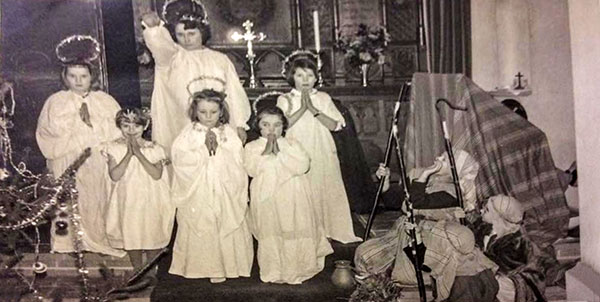 |
c.1963 |
Nativity play - c.1963 Back row - ?; Linda Gidney; Gloria Baker Front row - Sally Gee; ?; Gwen Baker; ?; ? |
 |
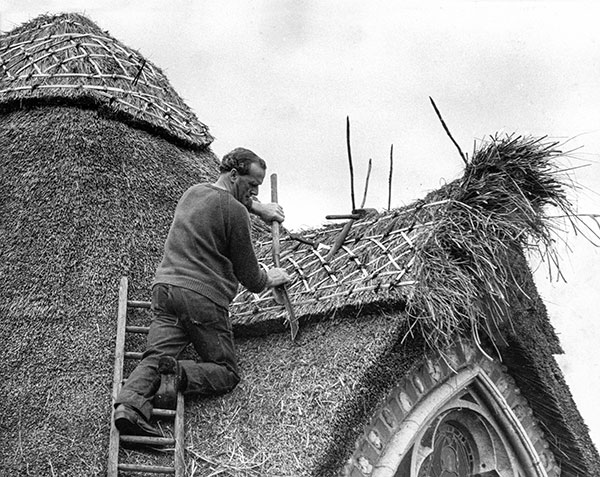 |
c.1975 after the railings around the sycamore tree had been removed |
Rethatching with Norfolk reed, sedge grass and hazel twigs - c.1975 |
Church history |
|
Sometime between the 1728 Corbridge map of Green Farm, which shows the Church with quite a large tower and 1744 when the (reduced) tower was put in order, there was a major collapse. This led to a decision by the Parish to rebuild the partially collapsed tower and to pay for the repairs by selling two of the three bells. In 1743 a Petition was prepared in the name of the Reverend John Grey the Vicar, John Staines the Churchwarden, Daniel Abill the Overseer and other parishioners. (This is exceedingly curious since according to the Revd Auden's researches the Vicar from 1742 was one Richard Chase!). For reasons unknown, the Petition did not proceed in its then form, there being endorsed on the outside of the Petition “Mr John Grey Vicar of the Parish of Hempstead having refused to sign, this Petition was prepared and signed by Robert Britiffe Esq Impropriator”. Furthermore his signature was supported by other parishioners, including John Wood, Gent of Green_Farm who was then almost certainly the most influential village resident. Despite the Vicar's refusal to support the Petition, the faculty was granted (NRO 23240 Z 92). The faculty of 1743 (NRS12994) partly reads as follows - There is a detailed account signed by John Staines and Daniel Abill listing the cost of the demolition and rebuilding which came to £67 - 02 - 9½ John Staines The Revd Auden records “Before the harmonium was placed in the church a village band led the music. A Mr Wright father of the Clerk and Sexton (1886-1916) was conductor, and a brother also played. Miss Beckett was organist for sixteen years 1890-1906. In 1901 a new Estry organ costing £17 took the place of the harmonium. This was replaced in 1932 by the present American organ” In notes left by Mr Auden appears the following: - The sad shortage of memorials came to an abrupt end with the arrival as Vicar of Charles Louis Rudd in 1873 who must have been a man of enormous energy and, presumably, wealth. John Trohear Rudd Capt HM 59th Rgt died 27.6.75 WM Frederick John Rudd Lieut Colonel Royal Scots died 13.8.68 (this window was executed by W C Constable FSA of Cambridge)'' The Reredos is equally uninformative saying that it “is erected to the memory of three sisters by their brother Charles L Rudd MA Vicar of this Parish 1886''.
It is curious that the Vicar's memorials do not list the names of those commemorated (ie “three sister”) while Mrs Rudd's memorials are more explicit. Charles Rudd also gave the harmonium in memory of his brother Captain John Rudd. He had died just after the Vicar was inducted when maybe a harmonium was urgently required. But why was John Rudd given a second commemoration in the window? The Revd A. M. Auden had a son Jack who emigrated to Canada. Jack's sister Rachel later commemorated him with a flower stand (first given to Sheringham Church but later removed and given to Hempstead Church). The inscription reads - |
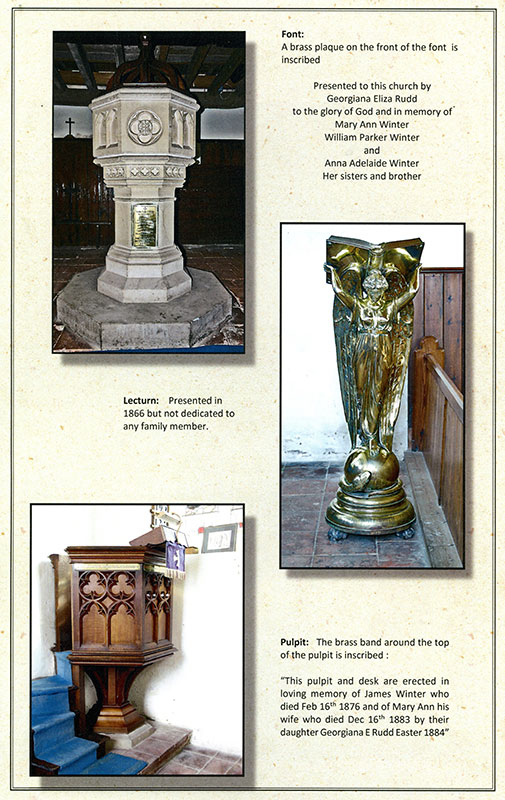 Church furniture - page from Geoffrey Harris' church pamphlet Church furniture - page from Geoffrey Harris' church pamphlet |
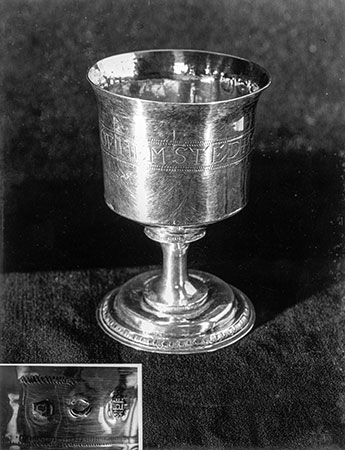 |
Communion Cup FOR THE TOWN OF HEMSTED 1568 |
In notes left by Rev. Auden appears the following: - |
I was very excited to come across your website this morning while researching my family tree. On your church history page you mention the name of an ancestor which was familiar to me, The first name is slightly different to the one I have from the marriage record, that of Wiggen West (you have it as Miggott West) who was my 7th Great-Grandfather. He married Edna Purdy at All Saints' Church on 5 Oct 1715. They had three sons, Christopher, baptised 29 Jul 1716, Edmund (my 6th Great-Grandfather) baptised 26 Apr 1719 and William baptised 17 Aug 1725. Unfortunately Edna was buried the following day, 18 Aug 1725. On 25 Mar 1726 Wiggen married his second wife, Martha Andrews at All Saints' Church. Laura - 22nd July 2021 |
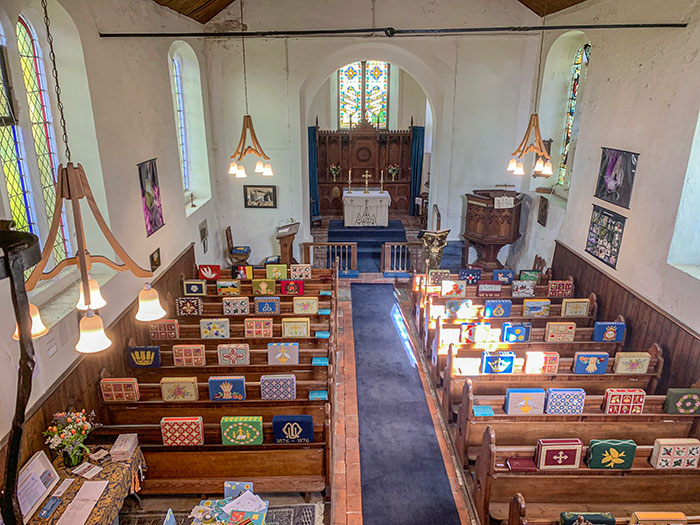 |
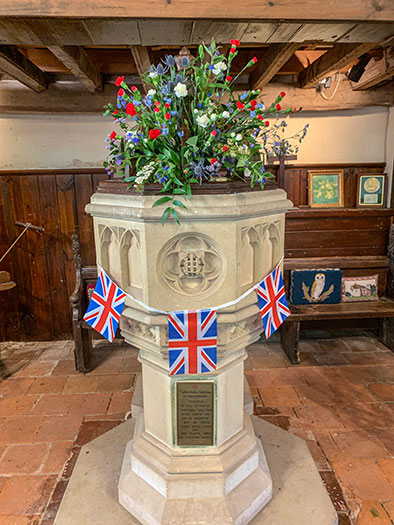 |
5th May 2023 |
Coronation flowers by Lis Hill - 5th May 2023 |
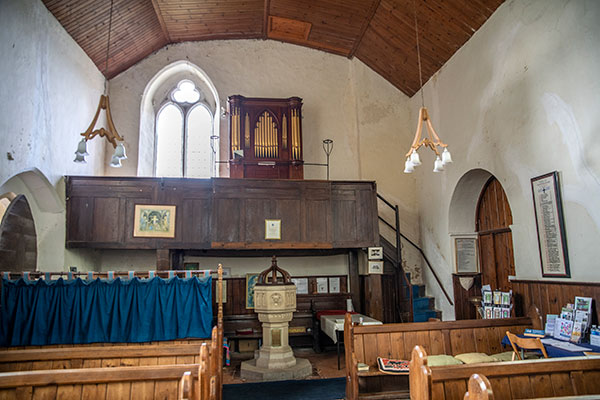 |
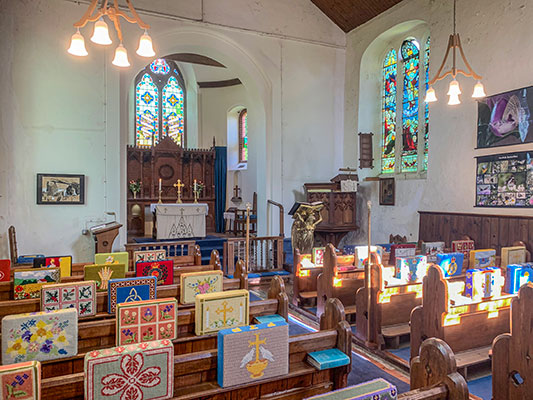 |
Font and balcony - 11th March 2020 |
5th May 2023 |
Vicars and Vicarage |
Where did the earlier vicars and curates live - if indeed they lived in the Parish at all? In East Anglian Archaeology Report No 8 (Norfolk) Andrew Rogerson and Nick Adams have written a fascinating report on the excavation of the moated site to the south-west of the church which they concluded was the site of the lost medieval Lose_Hall. ln that report they considered also the possibility of the site being that of the original vicarage and recorded the following information:- Rogerson goes on to state ''The Glebe Terrier of 1613 places the vicarage to the south of the church and between the road and the manor close and described it as "a dwelling house and a barne with one little outhouse . . .'' So somewhere underground to the west of the village playground there must still be the foundations of the original vicarage, its “barne'' and outhouse. Presumably it was Robert Watson, vicar between 1599 and 1649 but also Vicar of Bodham and Baconsthorpe, in one of which villages he may have lived, who let the former vicarage fall down so that since the mid-l7th century to 1876 there was nowhere in the village for the vicar or (unless he took lodgings) for the curate to live. Historically many parishes were held in plurality - a practice increasingly under criticism in the middle of the 19th Century as can be seen in Trollope's Barchester novels. In any event, before that, it was commonly said that “In the 18th Century the Church slept”. Hempstead seems to have been typical with the tower being allowed to fall down in the seventeen-thirties. At the time of its rebuilding in 1744 the Vicar was conspicuous by his absence with the responsible churchwarden being permitted to record his own success in rebuilding it with his own named and dated plaque so prominently displayed. Oxford Movement and the great wave of reform that so changed the Church of England in the latter part of the 19th Century, Nowhere else did this wave operate more spectacularly than in Hempstead with the arrival of Charles Louis Rudd in 1873 after the death of the Rev. J. C. Leak who had been Curate of Hempstead for 14 years but Rector of Birmingham Parva for no fewer than 45 years. Within three years, in 1878, the new vicarage, built by public subscription, was erected on the Glebe Land adjoining the Church. The architect was J. B. Pease of Norwich and the builder R. Cornish of North Walsham. The whole of the Church was furnished at the expense of Mr. & Mrs. Rudd with pulpit, reading desk, lectern, font, chandelier, reredos and harmonium as memorials to members of their family. Not content with their achievements the Vicar, one year after building the vicarage, built the infant school (later to become the Reading Room). In the parish magazine for October 1877 it was recorded that “a room capable of holding 80 people has just been erected by public subscription. It is built of stone and red brick and has a neat appearance. The want has been long felt in the parish of a building which would answer the two fold purpose of an infant school and Parish Room. Mr. West of Holt is the builder'' A hundred years later Mrs. Diana Spalton when converting the school (bought from the Diocese) into a house for herself discovered a number of letters from former pupils thanking the Rev. Rudd for educating them there. Mrs. Claudine Fuller (1916-1998) who lived in Hempstead all her life, recalled the Vicarage in her childhood - particularly the much loved Gleave family. They organised for the village children tableaux and picnics in the woods. All the village took part in the money-raising for the Apse in 1925 and 1926. The Sunday School every year had its outing at Sheringham, being taken in Mr. Hagen's Waggon. The vicarage then went into limbo. It was let for a number of years. Colonel Philip Shirley was a tenant and was Church Secretary and Treasurer from before 1960 until 1977. At one stage it was occupied by schoolmasters at Gresham's. It was really sold in the late nineteen-seventies and became owned by Mr. John Thomson. |
Alfred John “Jack” Auden 1898-1973 |
||
Alfred John “Jack” Auden was born in 1898 in Clun, Shropshire
He was called up August 1916 and served on the Western Front, 1916-18 He served in the West Yorkshire Regiment & Royal Engineers until demobbed
He then emigrated to Canada after the War and became a professional forester
He obtained a Master of Forestry from Yale in 1923 (“M.F.”) & worked for Abitibi P&PHe worked in Northern Ontario for over 30 years & rose to be Woodlands Manager
He proposed establishing woodland villages to settle the north for timber extraction
The town of Auden (Thunder Bay District), yes, named for him, was established in 1947
Auden, an Abitibi company town, now an indigenous community, was built to harvest wood pulp for newsprint; it has since gone the way of newsprint, but exists. “Auden Township” (Cochrane District), is 426 kms to the SE, named in 1907 for the relative discussed in the pamphlet. (These are two distinct places) The two Audens are geographically as far apart as Hempstead & Newcastle-on-Tyne.
|
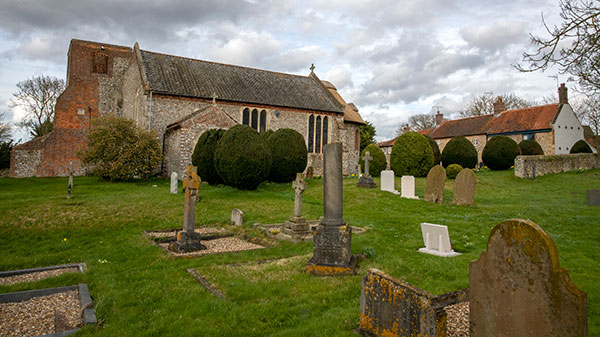 |
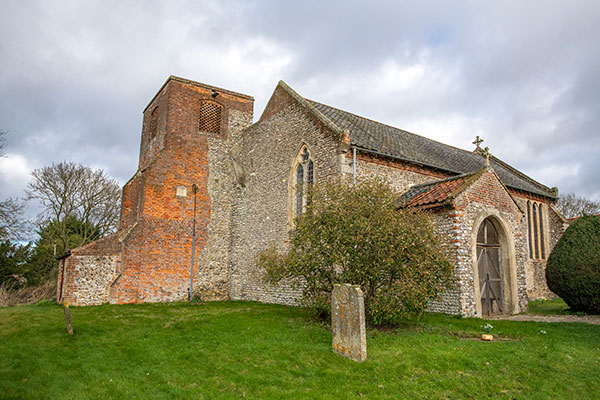 |
Church cottages backing directly onto the churchyard - 11th March 2020 |
The truncated tower containing a single bell - 17th February 2020 |
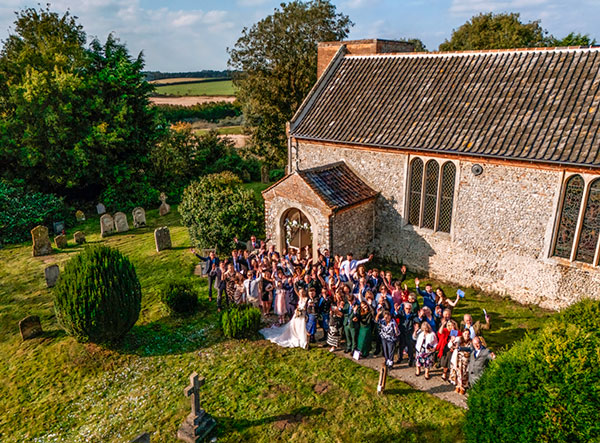 |
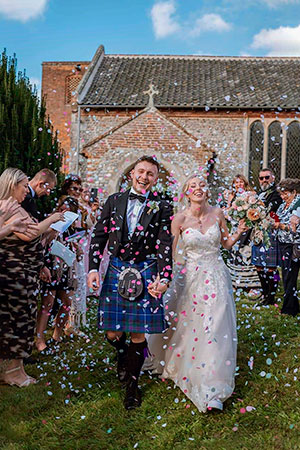 |
Hempstead Church hosted its first wedding in some considerable time, when Finlay Bond and Samantha Lambert |
|
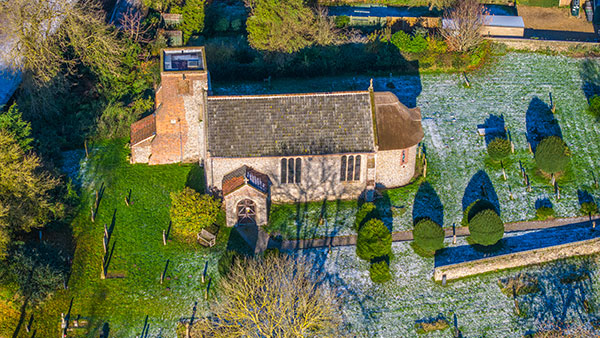 |
21st November 2024 |
Church Wardens |
||||
| Christopher Hunt William Kinge |
1602 |
Thomas Rump William Scott |
1824 |
|
| Christopher Hunt William Kinge |
1605 |
Thomas Rump William Scott |
1825 |
|
| John Jell John King |
1607 |
Thomas Rump William Scott |
1826 |
|
| George Blets ? Richard Boone |
1609 |
Benjamin Ling Charles Millar |
1834 |
|
| John Jell John King |
1612 |
Benjamin Ling Charles Millar |
1837 |
|
| John Brett Thomas Hunte |
1619 |
Benjamin Ling Charles Millar |
1838 |
|
| Myles Gooding William Polfe |
1623 |
Benjamin Ling Charles Millar |
1842 |
|
| Thomas Bishop Charles Harper |
1626 |
Joseph Bicket William Bird |
1868 |
|
| John Brett William Stedman |
1630 |
Joseph Bicket T. Ling |
1874-77 |
|
| James Dixe Charles Harper |
1635 |
Joseph Bicket Edmund Ling |
1879 |
|
| George Plumstead Robert Spurrell |
1637 |
John Hagen Richard Hardy |
1913 |
|
| Robert Flaxman John Wallett |
1638 |
John Hagen Richard Hardy |
1914 |
|
| John Newbegin John Trud |
1657 |
John Hagen Cecil Tatum |
1915 |
|
| John Staines | 1723-52 |
John Hagen Cecil Tatum |
1916-22 |
|
| John Sterring | 1744 |
Daniel W. Hagen John Hagen |
1932 |
|
| John Kemp Thomas Mickleburgh |
1768 |
Daniel W. Hagen John Mee |
1936 |
|
| John Button Thomas Rump |
1814 |
Daniel W. Hagen Richard Mack |
1937 |
|
| John Button Thomas Rump |
1815 |
John A Hagen | 1954 |
|
| John Button Thomas Rump |
1816 |
Henry Mack | 1955-99 |
|
| John Button Thomas Rump |
1818 |
Michael Culverwell | 1999 |
|
| James Bagper Thomas Rump |
1819 |
Henry Mack | 2005 |
|
| Thomas Rump William Scott |
1820 |
Ann Udale | 2008 |
|
| Thomas Rump William Scott |
1821 |
Ann Udale Su Summers |
2009 |
|
| Thomas Rump William Scott |
1823 |
Airlie Inglis | 2020 |
|
Overseers of the Poor
|
|
| James Emery | 1814 |
| John Button Thomas Rump William Scott |
1815 |
| Robert Bird Thomas Oliver |
1816 |
| John Dagless Thomas Rump snr |
1817 |
| Thomas Rump jnr Shore Oliver John Button |
1818 |
| John Edwards Shore Oliver |
1819 |
| John Edwards | 1822 |
| Thomas Rump John Edwards Benjamin Ling |
1823 |
| William Ellis Thomas Rump |
1824 |
| John Edwards William Scott |
1825 |
| Martha Ling Thomas Rump |
1826 |
| Benjamin Ling Thomas Rump |
1827 |
Incumbents |
|||
| Ralph de Birstin instituted vicar, presented by the prior and convent of Norwich | 1301 |
William M. Marcon Curate of Hempstead and Rector of Edgefield | 1814 |
| Simon de Eggefield presented by the prior, &c. | 1322 |
John Gunton Curate of Hempstead | 1833-1839 |
| John Chatres | 1338 |
John William Methwold also Vicar of Wighton and curate of Wetheringsett | 1835 |
| John Wryght | 1351 |
J. C. Leake Curate of Hempstead for 45 years | 1859 |
| John Vicar of Hemstede mentioned in the will of Thomas de Heydon | 1370 |
Charles Louis Rudd | 1873-1889 |
| Michael Crow by the prior and convent of Norwich | 1385 |
Thomas Webster Whistler | 1889-1911 |
| Record lost. | 1385-1520 |
James Robert Hamilton | 1913 |
| John Estmond | 1520 |
Claude Tennant Eastman | 1923 |
| Henry Yarham | 1523 |
Paul Rogers Cleave | 1924 |
| John Walett (deposed 1553) | 1543 |
Francis John Prior Wallis | 1932 |
| John Cooke | 1544 |
Alfred Millington Auden | 1933 |
| Robert Watson also rector of Bodham & Baconsthorpe | c.160 - 1610+ |
John William Leneve Norman Curate in charge | 1944 |
| Nicholas Bacon | 1662 |
Walter Percival Tippen also Rector of Baconsthorpe with Plumstead | 1947 |
| John Gray (Instituted) | 1694 |
Charles Scott Little also Rector of Baconsthorpe with Plumstead | 1953 |
| Richard Chase | 1742 |
Francis C. S. Allen also Rector of Baconsthorpe with Plumstead | 1960 |
| John Custance Curate of Hempstead | 1744 |
Stanley F. Hooper also Rector of Barningham, Matlaske, Baconsthorpe & Plumstead | 1979 |
| William Pierce | 1746 |
Piers W. E. Currie Priest in charge, also of Baconsthorpe | 1983 |
| Thomas Meux Curate of Hempstead | 1766 |
David C. Candler also Rector of Barningham, Matlaske, Baconsthorpe & Plumstead | 1985 |
| Edward Tilson | 1768 |
Paul J. Bell | 1995 |
| William Tower Johnson Curate of Plumstead, Rector of Beeston ministered more or less frequently |
1770 |
Michael L. Banks | 2003 |
| John Smith Rector of Holt ministered at Hempstead from time to time | 1772 |
Philip W. Butcher | 2006 |
| Francis Bransby Curate of Hempstead and Rector of Edgefield |
1778 |
Michael Cartwright | 2009 |
| John Ambrose Tickell | 1787 |
Marion J. Harrison | 2015 |
| Stephen Frost Rippingale Curate | 1814 |
Michael Cartwright | 2018 |
| John Lang Girdlestone Curate of Hempstead and Rector of Baconsthorpe | 1814 |
Rev. Canon David Longe | Present |
1385-1520 - at that time vicars were often laymen. Such vicars appointed priests as chaplains whose names were not always carefully recorded. |
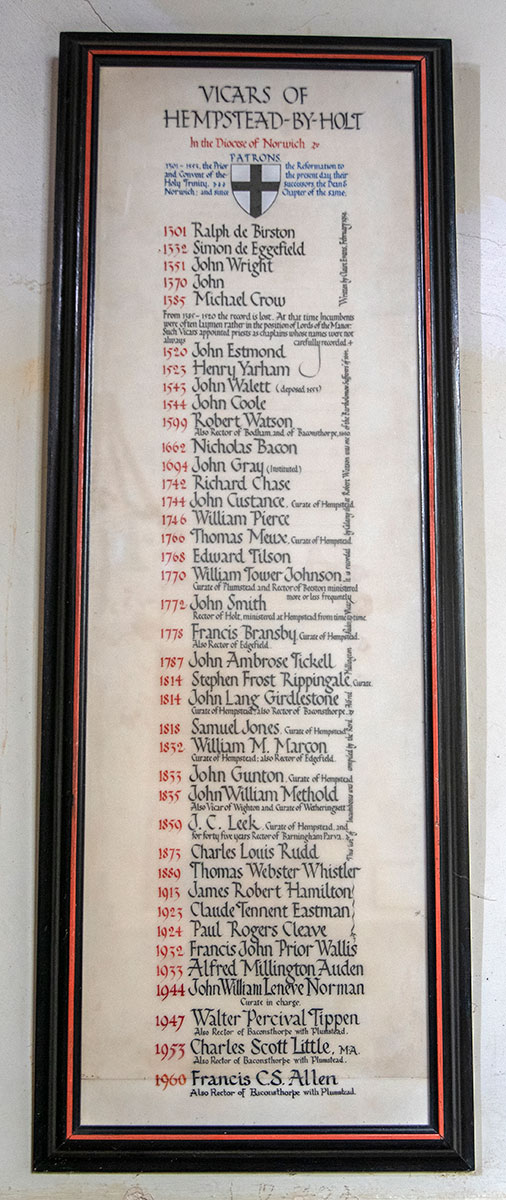 |
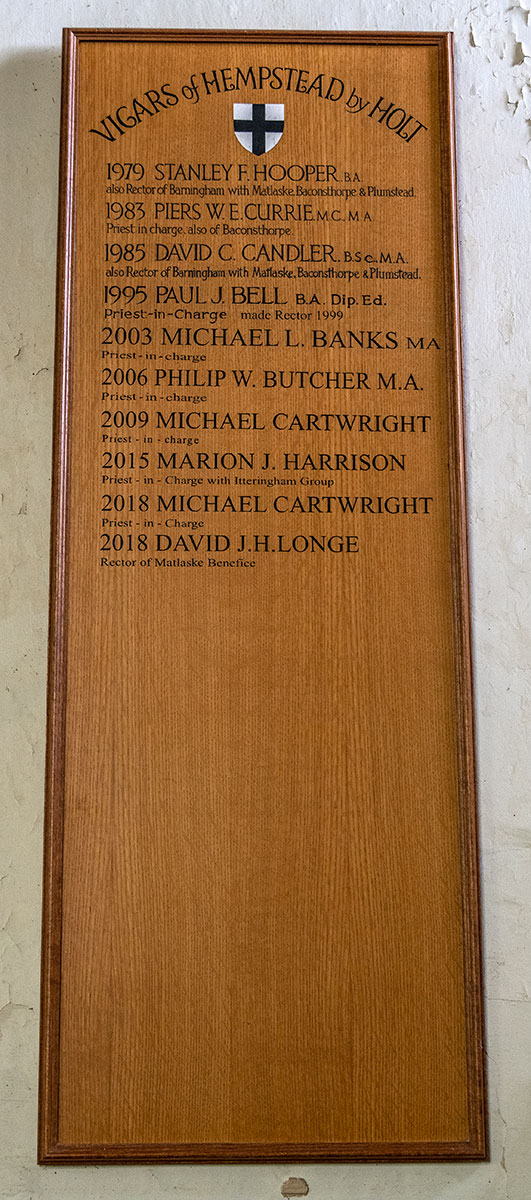 |
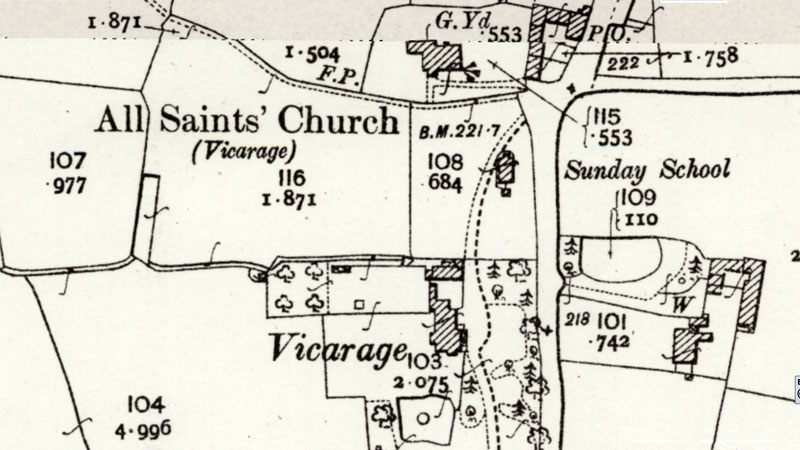 |
O. S. Map 1905 Courtesy of NLS map images |
If you have any memories, anecdotes or photos please let us know and we may be able to use them to update the site. Please
or telephone 07836 675369 |
Website copyright © Jonathan Neville 2023 |